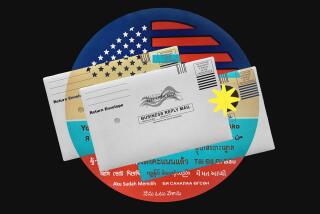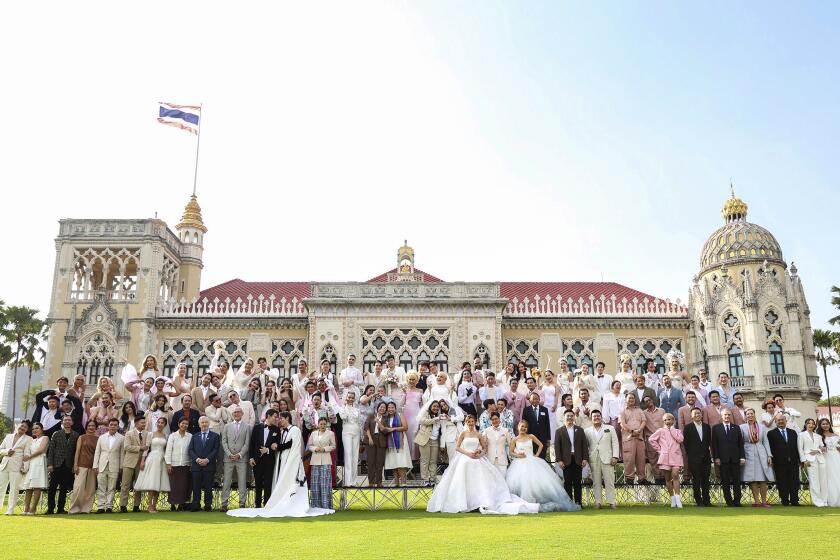VOTING : The Trouble With Turnout
- Share via
NEW YORK — Only about half the American electorate will go to the polls in November, 1988, compared with levels between 75% and 95% in other Western democracies. Even people in developing countries, such as India and El Salvador, turn out more than Americans.
Since it is the poorly educated in the United States who vote least, Americans generally attribute low voting to inadequate civic or political education. But why then do the less-educated citizens in other major democracies vote almost as faithfully as the better-educated?
High turnout is encouraged in other countries because citizens are placed on registration lists automatically when they come of age, or they are registered periodically by government-sponsored door-to-door canvasses. In the United States, by contrast, it is up to each citizen to figure out how and where to register, and that may not be an easy matter, especially for poorer and minority people. As a result, only 63% of those eligible are registered; more than 65 million are not, and two out of three of the unregistered are below the median income. (Elections officials claim that 75% are registered, but this figure is based on local lists clogged with the names of millions of people who have died, or who are counted twice because they have moved and re-registered elsewhere.)
Furthermore, the U.S. Census Bureau reports that people “overwhelmingly go to the polls” once they are registered. In 1984, 88% of the registrants voted, including 78% of those with eighth-grade educations or less.
It is worth remembering that America had the highest rate of voting in the world in the 19th Century, despite low education levels. But that was before politicians created voter registration requirements. Turnout plummeted at the beginning of the 20th Century when poll taxes, literacy tests and long-term residency requirements were introduced. At the same time, voter registration offices were opened in county seats where citizens had to prove to often-intimidating, hostile officials that they met registration qualifications.
With blacks and most poor whites disenfranchised in the South, presidential turnout in the region fell from an average of 67% in the latter half of the 19th Century to a low of 19% in 1924 (and it did not rise appreciably until the post-World War II struggle for voting rights). Literacy tests and obstructive registration procedures also reduced Northern presidential turnout from an average of 83% in the elections of the late 19th Century to 55% in the early 1920s. Indeed, 14 Northern states were using literacy tests as late as 1970, when they were outlawed by amendments to the Voting Rights Act.
Although poll taxes and literacy tests are things of the past, many people must still go to a county seat during working hours to register--forms are frequently complex and elections officials still often intimidate. Even the 24 states that allow people to register by mail have no system to make the forms widely available.
Then what continues to be astonishing about the United States is the resistance to making it convenient to register. Many politicians argue that it shouldn’t be easy, that people ought to earn the privilege to vote. But the registration system is supposed to be a method of listing eligible voters, not of weeding out those whom politicians consider undeserving.
Registration barriers are not the only reason that turnout is low, nor were they the only reason that turnout fell in the first place. With voting by the have-nots restricted in the early 20th Century, party organizers turned away from the candidates, the policies and the campaign language that would attract them. This marked a major difference in the course of political development in other industrial democracies where parties emerged to articulate the interests of working-class people and to mobilize them as voters.
The tendency of poorer and minority people to abstain from voting because of registration restrictions was thus reinforced when they were pushed to the margins of the political dialogue. This may explain much about the relative lack of class-consciousness among American workers. Unlike the labor parties of Europe, the American parties were not forced to give form and voice to a distinctive class politics.
Even the celebrated New Deal Democratic Party was not a party of working people in the same sense as the labor parties of Europe, because it was based on a most unhomogeneous coalition. Northern industrial workers who favored union rights and social programs were joined with better-off Southern whites who favored right-to-work laws and generally opposed social-welfare protections. Naturally enough, Southern Democrats elected to the Congress readily joined with Northern Republicans, and the resulting conservative alliance dominated postwar policy. The New Deal party, in short, was divided against itself--and against working people.
There is a simple, cheap and fraud-free way to expand registration, one endorsed by the National League of Cities, the U.S. Conference of Mayors and a special task force on Barriers to Voting of the National Assn. of Secretaries of State, the nation’s chief elections officers. Permit government employees to ask people who apply for services whether they would like to register to vote. Sixteen states have “motor voter” programs that allow people to register to vote in motor vehicle offices. Some states, counties and municipalities are registering people in libraries, or in health, welfare, unemployment and public utility offices. It is even possible to register in some nonprofit agencies, such as day-care and family-planning centers.
Yet it is an uphill fight to persuade state, county and municipal legislatures to enact agency-based voter registration bills, or to persuade governors, county executives and mayors to establish agency-based registration by executive orders. And even when they do act, there is often no administrative follow-through.
A number of key congressional Democrats and Republicans are supporting the Universal Voter Registration Act of 1988. Among other things, the bill would require that all federal agencies--and all federally assisted state and local agencies--offer registration services to the public, thus making voter registration the single most widely available service offered by government. But the bill’s prospects are cloudy.
One reason is that major businesses, which finance the parties, are hardly likely to go along with an increase in have-not voting at a time when they press Congress to cut social programs. Party opposition is another reason. Many Republicans fear that higher voting by poorer and minority people would benefit the Democrats, even endangering their hold on the presidency. The Democrats have their own fears: An upsurge of have-not and minority voting would disrupt the balance of voter blocs within the party, eroding support among some groups and strengthening it among others (as Jesse Jackson’s campaign suggests).
Finally, incumbency is a major source of opposition, as President Jimmy Carter explained after his voter-registration reform bill went down to defeat in 1977: “The more senior and more influential members of the Congress have very safe districts. To have a 25% or 30% increase in unpredictable new voters is something they don’t relish.”
Of course, no one can be sure that millions of poorer and minority non-voters would go to the polls if registration procedures were reformed, or that they would vote differently than better-off whites. What is certain is that there is a good deal of opposition to finding out.
More to Read
Sign up for Essential California
The most important California stories and recommendations in your inbox every morning.
You may occasionally receive promotional content from the Los Angeles Times.










